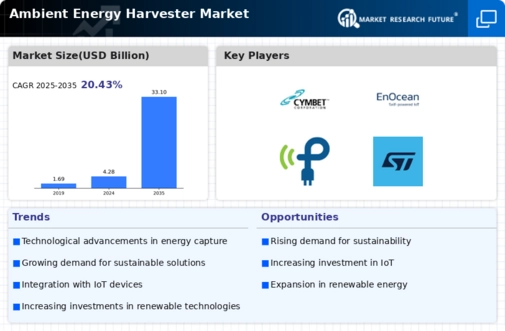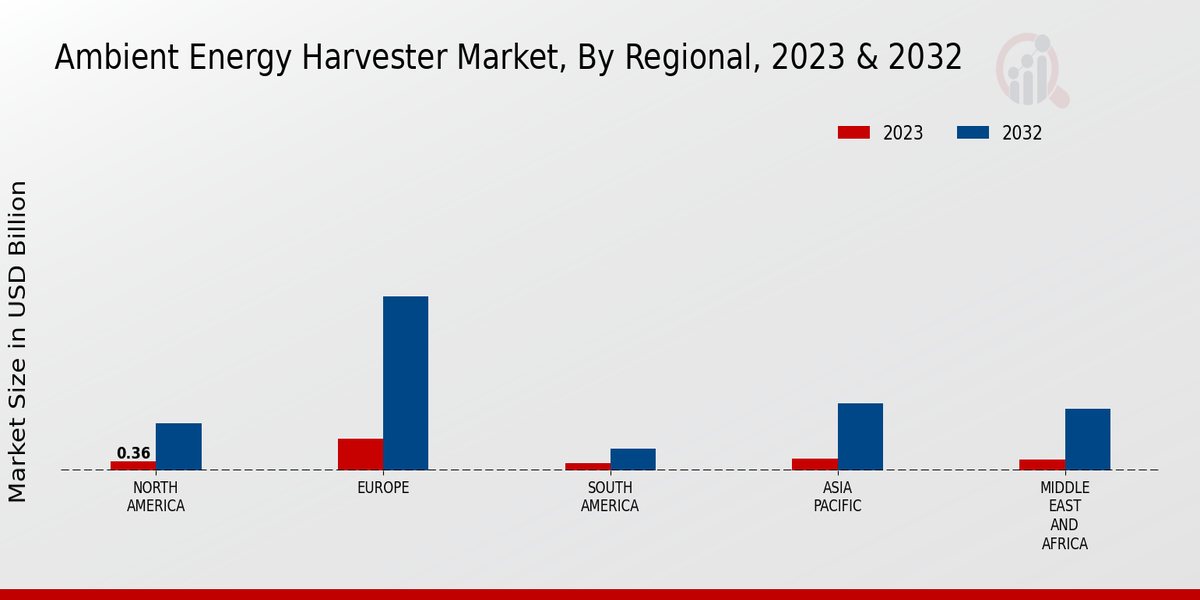Market Growth Projections
The Global Ambient Energy Harvester Market Industry is projected to experience substantial growth, with forecasts indicating a rise from 4.28 USD Billion in 2024 to 33.1 USD Billion by 2035. This growth trajectory suggests a compound annual growth rate (CAGR) of 20.43% from 2025 to 2035. Such projections highlight the increasing recognition of ambient energy harvesting as a viable energy solution across various sectors. The anticipated market expansion reflects not only technological advancements but also the growing demand for sustainable energy sources, positioning ambient energy harvesters as a critical component in the transition towards a greener economy.
Government Initiatives and Funding
Government initiatives and funding are crucial drivers of the Global Ambient Energy Harvester Market Industry. Various governments are investing in research and development to promote clean energy technologies. For example, the U.S. Department of Energy has allocated significant funding towards projects that focus on energy harvesting solutions. These initiatives not only support innovation but also create a favorable regulatory environment for market participants. As a result, the market is likely to witness increased participation from startups and established companies alike, further accelerating growth and adoption of ambient energy harvesting technologies.
Integration of IoT and Smart Technologies
The integration of Internet of Things (IoT) and smart technologies is transforming the Global Ambient Energy Harvester Market Industry. As smart devices proliferate, the need for efficient energy sources becomes paramount. Ambient energy harvesters provide a sustainable solution for powering IoT devices, which often require continuous energy supply. For instance, smart sensors used in smart cities can leverage energy harvesting technologies to operate autonomously without the need for battery replacements. This trend not only enhances the functionality of smart devices but also contributes to the overall growth of the market, as more industries adopt these technologies to improve operational efficiency.
Growing Applications Across Diverse Industries
The Global Ambient Energy Harvester Market Industry is witnessing growing applications across diverse industries, which is a key driver of its expansion. From healthcare to transportation, ambient energy harvesters are being utilized to power devices and systems that require low-power energy solutions. For instance, in the healthcare sector, wearable devices that monitor patient health can benefit from energy harvesting technologies, reducing the need for frequent battery replacements. This versatility in applications not only broadens the market's reach but also encourages innovation, as companies explore new use cases for ambient energy harvesting.
Rising Demand for Sustainable Energy Solutions
The Global Ambient Energy Harvester Market Industry is experiencing a surge in demand for sustainable energy solutions as environmental concerns become increasingly prominent. Governments worldwide are implementing stringent regulations to reduce carbon emissions, which drives innovation in energy harvesting technologies. For instance, the European Union's Green Deal aims to make Europe climate-neutral by 2050, fostering investments in renewable energy sources. This trend is reflected in the market's projected growth from 4.28 USD Billion in 2024 to an anticipated 33.1 USD Billion by 2035, indicating a robust compound annual growth rate (CAGR) of 20.43% from 2025 to 2035.
Technological Advancements in Energy Harvesting
Technological advancements play a pivotal role in the Global Ambient Energy Harvester Market Industry, enhancing the efficiency and effectiveness of energy harvesting devices. Innovations in materials science, such as the development of piezoelectric materials and nanogenerators, have significantly improved energy conversion rates. For example, researchers have demonstrated that new piezoelectric materials can generate electricity from vibrations with higher efficiency than traditional methods. These advancements not only increase the viability of ambient energy harvesters but also expand their applications across various sectors, including consumer electronics and industrial automation, thereby driving market growth.
















Leave a Comment